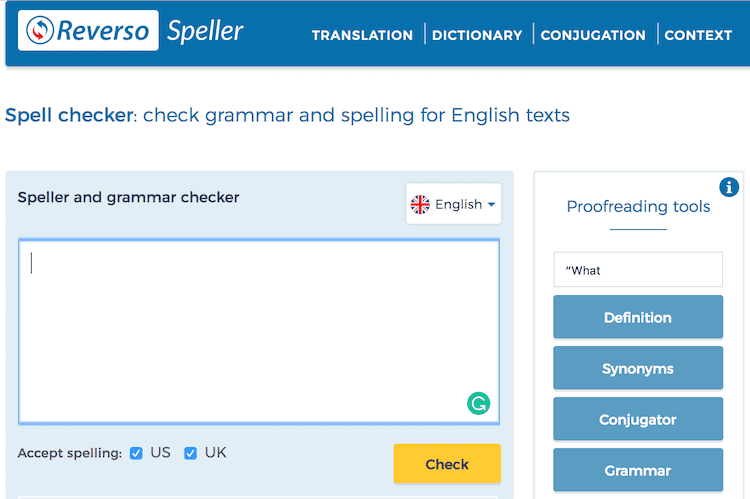
Correct My Grammar Errors Free To Use
If you find it helpful, we would appreciate it if you could help us spread the word by tweeting, sharing on. Feel free to use this service as often as you would like for both personal and business purposes. GrammarCheck.me uses an advanced, web-based grammar checking engine to power its free online spelling & grammar software.
Unfortunately, multilingual writers have been unfairly denied access to language feedback because of the very strong prohibition against editing, but the good news is that we can still be very helpful without compromising our principles.Grammar Check is an intelligent software program that will help you identify misspelled words, spaces, commas, and grammar mistakes. “Checking the grammar” can feel uncomfortably close to proofreading and editing students’ papers for them—which writing coaches know is strictly out of bounds. No changes to the sentences intended meaning Also, it is important to note that we did not state that the correct answer is always the most concise one.When you ask students writing in English as an additional language what they would like to work on, they will often say that they’d like you to check their grammar. Correct sentence structure 3. No grammatical mistakes 2. Benefits of Using an Online Grammar Check.“Just Check My Grammar” What this handout is aboutThe correct answer to any of our sentence correction questions will have all of the following 4 characteristics: 1.

The content of students’ essays should be discussed only as much as necessary for accurate error correction.The writing process was divided, the writing center’s territory was firmly staked, and the perceived needs of multilingual writers were placed squarely outside the parameters of the writing center’s mission, pedagogical philosophy, and standard procedure. Friedlander: Assertion that writing centers meet the needs of foreign students by focusing on mechanical remediation and error correction. “In a writing center, the object is to make sure that writers, and not necessarily their texts, are what get changed by instruction…our job is to produce better writers, not better writing” (p. North: Staunch declaration that writing centers were not centers for mechanical remediation and error correction.

Lectures about how we teach proofreading strategies or how we don’t really do grammar in the writing center put students on the defensive when they have a legitimate need for feedback on their language proficiency. (“Sure, we can take a look at the language stuff…). What do you do when students say, “Just check my grammar”?
We know that language learners are able to understand a lot more than they are able to spontaneously produce in a foreign language, and it’s really hard work to express complex thoughts sufficiently in a language that’s not your own. Explaining their writing project (the assignment and the text so far) gives students the chance to produce “comprehensible output”—a chance to use the English language to express their thoughts clearly and to make themselves understood. (“Before we get started, could you tell me about what you’re working on and what you’ve included so far?”). Students will often identify quite a range of concerns with simple prompting at the beginning of the session, especially after they’ve been reassured that you’ll help them identify problems with a language they’re still learning. (“What else would you like to talk about today? Are you still working on the content?”).
Sometimes a sentence may be so malformed that the idea is completely obscured. Stop only for extreme issues. You’ll get a sense of the student’s complete argument, and you’ll have time to recognize more serious errors that may occur later in the paper. You may find grammatical errors on the first or second page, but keep reading.
If you understood and explained correctly, the student can hear the thought expressed in grammatical English and can make note of it—they can add it to their English language repertoire. (“Let me see if I understand you correctly. Recast the student’s explanation more grammatically. Clarifying these expressions takes priority over minor errors that don’t really interfere with your understanding. Try to be attuned especially to places where the student’s language use is truly interfering with your ability to understand what they’re trying to say.
We say it like this.” “Oh, okay. This back and forth process is called “negotiation of meaning” (“Is this what you mean?” “No, I mean this.” “Oh, okay. Then you can work together on correcting whatever is confusing about the student’s original expressions.
If you’ve listened carefully enough that you know what they’re trying to express, help them out. You are not usurping control if you make language suggestions that convey the student’s ideas. This “input” might be bits of English that are new to them (like a new word or idiomatic expression), or it might be familiar bits of English being used in ways they’ve never heard before.
Normally we teach proofreading strategies to native speakers at this stage. They’re satisfied with everything else, and as writers, you know that’s a happy place to be. It may serve as a useful training sample, so you’re serving the community well.What if students really mean, “Just check my grammar”?There does come a time writers are ready to concentrate strictly on their grammar. If you encounter particularly interesting or confusing samples of language use, keep a copy to share with your colleagues and mentors.
Second, when you do find an error, you can ask, “How do you normally proofread for this kind of mistake?” or say to the student, “Let’s try to find a few more examples of this structure, just to double-check them.” Look for correct and incorrect examples because we need our successes reinforced too! It’s a great opportunity to assess the student’s proofreading skills and do some strategy building.Think of these strategies as being listed in the order they should be used in, but feel comfortable to experiment with the order, depending on the student, the writing project, and your own judgment. You can still exploit the educational value of an error, having confidence that students will try to apply what they learn to their subsequent writing.Two things to note: First, even though the strategies listed below concentrate more on straight proofreading and grammar checking, remember that you can also use all of the strategies listed above for correcting the grammar by clarifying the intended meaning. Sometimes that does happen, but more frequently, there will only be one or two instances of twenty five different kinds of error. These suggestions are meant to help you with that adjustment.There’s a strong misconception that there will be “patterns of error”—certain types of errors that occur repeatedly in the text.


 0 kommentar(er)
0 kommentar(er)
